Tool Wear Issues in Hot Forging of Steel
Abstract
1. Introduction
2. Materials and Methods
3. Results and Discussion
3.1. Die Insert for Forging “Fork-Type” Forgings
3.1.1. Macroscopic Evaluation of Die Damage
3.1.2. Evaluation of Macrostructural Banding of Damaged Die Insert
3.1.3. Evaluation of the Microstructure of a Damaged Die Insert
3.1.4. Surface Layer in the Tribological Contact Area
3.1.5. Fractography of the Die Insert Fracture Surface
3.1.6. Hardness and Fracture Strength Testing
3.2. Forging Die for Forging Wound Spreader Components
3.2.1. Macroscopic Evaluation of the Damage in Terms of Banding
3.2.2. Microstructure of Forging Die
3.2.3. Morphology of the Forging Die Surface Layer
3.2.4. Analysis of Forging Die Surface
3.2.5. Analysis of Fracture Propagation
3.2.6. Mechanical Properties
4. Conclusions
- The wear mechanism of a die (or die insert) is dependent on the location and its cavity, especially considering pronounced changes in curvature of the forged part negative shape. Fatigue cracks are formed at the points where the geometry of the die cavity changes due to material-forming operations.
- Performing heat treatment of the tool for obtaining high hardness is not a priority with regard to reducing hot working tool wear, as the initially hardened and tempered material is in almost constant contact with 1200 °C forged material. Additionally, we argue that the heat treatment reduced the overall wear resistance.
- An important wear mechanism of hot working tools is the oxidation process, occurring more rapidly at higher temperatures.
- The aerological effects of die cavity machining promote tool failure.
- Abrasive wear is characteristic of the tool surface, along which there is intense flow of the material being formed.
- The contact between the surfaces of the two dies in the case of a dynamic forging process provokes the formation of adiabatic shear bands.
- Tool cracking is associated with heat treatment, including tempering in the range of secondary hardness or tempering brittleness of the first kind. The separation of transition carbides after the boundaries of the former austenite grain is in this case unfavorable.
- The low degree of processing (low strains) of the material results in a decrease in the fracture toughness of the tool.
- The occurrence of banded microstructure results in anisotropic properties of the tool. Moreover, in the studied case the die cavities were misaligned in relation to the bands occurring in the material, being another factor in premature wear of the tool, as shown in Section 3.2.1.
- Nonmetallic inclusions, such as aluminum oxides, manganese sulfides, and molybdenum carbides, can facilitate tool fracture.
Author Contributions
Funding
Institutional Review Board Statement
Informed Consent Statement
Data Availability Statement
Acknowledgments
Conflicts of Interest
References
- Branch, N.A.; Subhash, G.; Arakere, N.K.; Klecka, M.A. A new reverse analysis to determine the constitutive response of plastically graded case hardened bearing steels. Int. J. Solids Struct. 2011, 48, 584–591. [Google Scholar] [CrossRef]
- Ҫimenoğlu, H. Subsurface characteristics of an abraded low carbon steel. Wear 1997, 210, 204–210. [Google Scholar] [CrossRef]
- Kato, H.; Sasase, M.; Suiya, N. Friction-induced ultra-fine and nanocrystalline structures on metal surfaces in dry sliding. Tribol. Int. 2010, 43, 925–928. [Google Scholar] [CrossRef]
- Pape, J.A.; Neu, R.W. Subsurface damage development during fretting fatigue of high strength steel. Tribol. Int. 2007, 40, 1111–1119. [Google Scholar] [CrossRef]
- Li, G.; Chen, J.; Guan, D. Friction and wear behaviors of nanocrystalline surface layer of medium carbon steel. Tribol. Int. 2010, 43, 2216–2221. [Google Scholar] [CrossRef]
- Kumar, S.; Bhattacharyya, A.; Mondal, D.K.; Biswas, K.; Maity, J. Dry sliding wear behaviour of medium carbon steel against an alumina disk. Wear 2011, 270, 413–421. [Google Scholar] [CrossRef]
- Kanchanomai, C.; Saengwichian, B.; Manonukul, A. Delamination wear of metal injection moulded 316L stainless steel. Wear 2009, 267, 1665–1672. [Google Scholar] [CrossRef]
- Markov, D.; Kelly, D. Mechanisms of adhesion-initiated catastrophic wear: Pure sliding. Wear 2000, 239, 189–210. [Google Scholar] [CrossRef]
- Wei, M.X.; Wang, S.Q.; Wang, L.; Cui, X.H.; Chen, K.M. Effect of tempering conditions on wear resistance in various wear. Tribol. Int. 2011, 44, 898–905. [Google Scholar] [CrossRef]
- Stachowiak, G.W.; Batchelor, A.W. Engineering Tribology, 2nd ed.; Butterworth-Heinemann: Boston, MA, USA; Oxford, UK; Auckland, New Zealand; Johannesbourg, South Africa; Melbourne, Australian; New Delhi, India, 2001. [Google Scholar]
- Torrance, A.A. The influence of surface deformation on mechanical wear. Wear 1996, 200, 45–54. [Google Scholar] [CrossRef]
- Tyfour, W.R.; Beyon, J.H.; Kapoor, A. Deterioration of rolling contact fatigue life of pearlitic rail steel due to dry-wet rolling-sliding line contact. Wear 1996, 197, 255–265. [Google Scholar] [CrossRef]
- Abouei, V.; Saghafian, H.; Kheirandish, S.; Ranjbar, K. An investigation of the wear behaviour of 0.2% C dual phase steels. J. Mater. Proces. Tech. 2008, 203, 107–112. [Google Scholar] [CrossRef]
- Han, J.; Zhang, R.; Ajayi, O.; Barber, G.; Zou, Q.; Guessous, L.; Schall, D.; Alnabulsi, S. Scuffing behavior of gray iron and 1080 steel in reciprocating and rotational. Wear 2011, 271, 1854–1861. [Google Scholar] [CrossRef]
- Scandian, C.; Boher, C.; de Mello, J.D.B.; Rézaï-Aria, F. Effect of molybdenum and chromium contents in sliding wear of high-chromium white cast iron: The relationship between microstructure and wear. Wear 2009, 267, 401–408. [Google Scholar] [CrossRef]
- Barrau, O.; Boher, C.; Gras, R.; Rezai-Aria, F. Analysis of the friction and wear behaviour of hot work tool steel for forging. Wear 2003, 255, 1444–1454. [Google Scholar] [CrossRef]
- El-Shabasy, A.B.; Lewandowski, J.J. Effects of load ratio, R, and test temperature on fatigue crack growth of fully pearlitic eutectoid steel (fatigue crack growth of pearlitic steel). Int. J. Fatigue 2004, 26, 305–309. [Google Scholar] [CrossRef]
- Yoon, H.K.; Lee, S.P.; Min, B.H.; Kim, S.W.; Katoh, Y.; Kohyama, A. Fatigue life and fatigue crack propagation behavior of JLF-1 steel. Fusion Eng. Des. 2002, 61-62, 677–682. [Google Scholar] [CrossRef]
- Kruml, T.; Polák, J. Fatigue cracks in Eurofer 97 steel: Part I. Nucleation and small crack growth kinetics. J. Nucl. Mater. 2011, 412, 2–6. [Google Scholar] [CrossRef]
- Hong, Y.J.; Xing, J.; Wang, J.B. Statistical analysis of fatigue crack growth for 16MnR steel under constant amplitude loads. Int. J. Pres. Ves. Pip. 1999, 76, 379–385. [Google Scholar] [CrossRef]
- Miller, A.; Estrin, Y.; Hu, X.Z. Magnetic force microscopy of fatigue crack tip region in a 316L austenitic stainless steel. Scr. Mater. 2002, 47, 441–446. [Google Scholar] [CrossRef]
- Shih, Y.S.; Chen, J.J. The frequency effect on the fatigue crack growth rate of 304 stainless steel. Nucl. Eng. Des. 1999, 191, 225–230. [Google Scholar] [CrossRef]
- Babu, M.N.; Sasikala, G.; Dutt, B.S.; Venugopal, S.; Albert, S.K.; Bhaduri, A.K.; Jayakumar, T. Investigation on influence of dynamic strain ageing on fatigue crack growth behaviour of modified 9Cr–1Mo steel. Int. J. Fatigue 2012, 43, 242–245. [Google Scholar] [CrossRef]
- Chikh, B.O.; Imad, A.; Benguediab, M. Influence of the cyclic plastic zone size on the propagation of the fatigue crack in case of 12NC6 steel. Comput. Mater. Sci. 2008, 43, 1010–1017. [Google Scholar]
- Naoe, T.; Yamaguchi, Y.; Futakawa, M. Quantification of fatigue crack propagation of an austenitic stainless steel in mercury embrittlement. J. Nucl. Mater. 2012, 431, 133–139. [Google Scholar] [CrossRef]
- Murtaza, G.; Akid, R. Modelling short fatigue crack growth in a heat-treated low-alloy steel. Int. J. Fatigue 1995, 17, 207–214. [Google Scholar] [CrossRef]
- Krawczyk, J.; Rożniata, E.; Pacyna, J. The influence of hypereutectoid cementite morphology upon fracture toughness of chromium-nickel-molybdenum cast steel of ledeburite class. J. Mater. Proces. Tech. 2005, 162–163, 336–341. [Google Scholar] [CrossRef]
- Krawczyk, J.; Bała, P.; Pacyna, J. The effect of carbide precipitate morphology on fracture toughness on low-tempered steels containing Ni. J. Microsc. 2010, 237, 411–415. [Google Scholar] [CrossRef]
- Krawczyk, J.; Pacyna, J. The influence of microstructure of mottled cast iron for mill rolls on its properties. In Proceedings of the Metal 2009: 18th International Conference on Metallurgy and Materials, Brno, Czech Republic, 18–20 May 2009; pp. 100–106. [Google Scholar]
- Torres, Y.; Rodríguez, S.; Mateo, A.; Anglada, M.; Llanes, L. Fatigue behavior of powder metallurgy high-speed steels: Fatigue limit prediction using a crack growth threshold-based approach. Mater. Sci. Eng. A 2004, 387–389, 501–504. [Google Scholar] [CrossRef]
- Rho, B.S.; Hong, H.U.; Nam, S.W. The fatigue crack initiation at the interface between matrix and d-ferrite in 304l stainless steel. Scr. Mater. 1998, 39, 1407–1412. [Google Scholar] [CrossRef]
- Lo, I.-H.; Tsai, W.-T. Effect of selective dissolution on fatigue crack initiation in 2205 duplex stainless steel. Corros. Sci. 2007, 49, 1847–1861. [Google Scholar] [CrossRef]
- Toribio, J.; González, B.; Matos, J.C. Fatigue crack propagation in cold drawn steel. Mater. Sci. Eng. A 2007, 468–470, 267–272. [Google Scholar] [CrossRef]
- Kim, S.; Kang, D.; Kim, T.W.; Lee, J.; Lee, C. Fatigue crack growth behavior of the simulated HAZ of 800MPa grade high-performance steel. Mater. Sci. Eng. A 2011, 528, 2331–2338. [Google Scholar] [CrossRef]
- Mustapa, M.S.; Mutoh, Y. Effects of size and spacing of uniformly distributed pearlite particles on fatigue crack growth behavior of ferrite–pearlite steels. Mater. Sci. Eng. A 2010, 527, 2592–2597. [Google Scholar] [CrossRef]
- Zhang, M.; Yang, P.; Tan, Y. Micromechanisms of fatigue crack nucleation and short crack growth in a low carbon steel under low cycle impact fatigue loading. Int. J. Fatigue 1999, 21, 823–830. [Google Scholar] [CrossRef]
- Li, S.; Xuan, F.Z.; Tu, S.T. In situ observation of interfacial fatigue crack growth in diffusion bonded joints of austenitic stainless steel. J. Nucl. Mater. 2007, 366, 1–7. [Google Scholar] [CrossRef]
- Hong, H.U.; Rho, B.S.; Nam, S.W. A study on the crack initiation and growth from α-ferrite/γ phase interface under continuous fatigue and creep-fatigue conditions in type 304L stainless steels. Int. J. Fatigue 2002, 24, 1063–1070. [Google Scholar] [CrossRef]
- Fernandez-Vicente, A.; Pellizzari, M.; Arias, J.L. Feasibility of laser surface treatment of pearlitic and bainitic ductile irons for hot rolls. J. Mater. Proces. Tech. 2012, 212, 989–1002. [Google Scholar] [CrossRef]
- Michalski, J.; Marszalek, J.; Kubiak, K. An experimental study of diesel engine cam and follower wear with particular reference to the properties of the materials. Wear 2000, 240, 168–179. [Google Scholar] [CrossRef]
- Belyaeva, L.A.; Zisman, A.A.; Petersen, C.; Potapova, V.A.; Rybin, V.V. Thermal fatigue crack nucleation in ferritic-martensitic steels before and after neutron irradiation. J. Nucl. Mater. 2000, 283-287, 461–464. [Google Scholar] [CrossRef]
- Wang, C.; Zhou, H.; Lin, P.Y.; Sun, N.; Guo, Q.; Zhang, P.; Yu, J.; Liu, Y.; Wang, M.; Ren, L. The thermal fatigue resistance of vermicular cast iron coupling with H13 steel units by cast-in process. Mater. Des. 2010, 31, 3442–3448. [Google Scholar] [CrossRef]
- Dobrzański, L.A.; Mazurkiewicz, J.; Hajduczek, E.; Madejski, J. Comparison of the thermal fatigue resistance and structure of the 47CrMoWVTiCeZr16-26-8 hot-work tool steel with X40CrMoV5-1 type one. J. Mater. Proces. Tech. 2001, 113, 527–538. [Google Scholar] [CrossRef]
- Sheffler, K.D. Vacuum thermal-mechanical fatigue behavior of two iron-base alloys. In Thermal fatigue of materials and components; ASTM International: Philadelphia, PA, USA, 1975; pp. 214–226. [Google Scholar]
- Starling, C.M.D.; Branco, J.R.T. Thermal fatigue of hot work tool steel with hard coatings. Thin Solid Film. 1997, 308–309, 436–442. [Google Scholar] [CrossRef]
- Kadlec, M.; Haušild, P.; Siegl, J.; Materna, A.; Bystrianský, J. Thermal fatigue crack growth in stainless steel. Int. J. Pres. Ves. Pip. 2012, 98, 89–94. [Google Scholar] [CrossRef]
- Grüning, A.; Lebsanft, M.; Scholtes, B. Cyclic stress–strain behavior and damage of tool steel AISI H11 under isothermal and thermal fatigue conditions. Mater. Sci. Eng. A 2010, 527, 1979–1985. [Google Scholar] [CrossRef]
- Persson, A.; Hogmark, S.; Bergström, J. Simulation and evaluation of thermal fatigue cracking of hot work tool steels. Int. J. Fatigue 2004, 26, 1095–1107. [Google Scholar] [CrossRef]
- Sjöström, J.; Bergström, J. Thermal fatigue testing of chromium martensitic hot-work tool steel after different austenitizing treatments. J. Mater. Proces. Tech. 2004, 153–154, 1089–1096. [Google Scholar] [CrossRef]
- Le Roux, S.; Medjedoub, F.; Dour, G.; Rézaï-Aria, F. Image analysis of microscopic crack patterns applied to thermal fatigue heat-checking of high temperature tool steels. Micron 2013, 44, 347–358. [Google Scholar] [CrossRef]
- Lapovok, R. Improvement of die life by minimisation of damage accumulation and optimisation of preform design. J. Mater. Proces. Tech. 1998, 80–81, 608–612. [Google Scholar] [CrossRef]
- Barrau, O.; Boher, C.; Vergne, C.; Rezai-Aria, F.; Gras, R. Investigations of friction and wear mechanisms of hot forging tool steels. In Proceedings of the 6th International Tooling Conference, Karlstad, Sweden, 10–13 September 2002; The Use of Tool Steels: Experience and Research, Karlstad, Sweden. 2002. [Google Scholar]
- Ebara, R.; Kubota, K. Failure analysis of hot forging dies for automotive components. Eng. Fail. Anal. 2008, 15, 881–893. [Google Scholar] [CrossRef]
- Lavtar, L.; Muhič, T.; Kugler, G.; Terčelj, M. Analysis of the main types of damage on a pair of industrial dies for hot forging car steering mechanisms. Eng. Fail. Anal. 2011, 18, 1143–1152. [Google Scholar] [CrossRef]
- Jung, I.; Lubich, V.; Wieland, H.-J. Tool failures-causes and prevention. In Proceedings of the 6th International Tooling Conference, Karlstad, Sweden, 10–13 September 2002; The Use of Tool Steels: Experience and Research, Karlstad, Sweden. 2002. [Google Scholar]
- Krishnadev, M.R.; Jain, S.C. Improved productivity through failure analysis: Case studies in precision forging of aerospace components. Eng. Fail. Anal. 2007, 14, 1053–1064. [Google Scholar] [CrossRef]
- Gagg, C.R. Premature failure of thread rolling dies: Material selection, hardness criteria and case studies. Eng. Fail. Anal. 2001, 8, 87–105. [Google Scholar] [CrossRef]
- Krawczyk, J.; Bembenek, M.; Pawlik, J. The Role of Chemical Composition of High-Manganese Cast Steels on Wear of Excavating Chain in Railway Shoulder Bed Ballast Cleaning Machine. Materials 2021, 14, 7794. [Google Scholar] [CrossRef] [PubMed]
- Bembenek, M.; Krawczyk, J.; Pancikiewicz, K. The Wear on Roller Press Rollers Made of 20Cr4/1.7027 Steel under Conditions of Copper Concentrate Briquetting. Materials 2020, 13, 5782. [Google Scholar] [CrossRef] [PubMed]
- Krawczyk, J.; Bembenek, M.; Frocisz, Ł.; Śleboda, T.; Paćko, M. The effect of sandblasting on properties and structures of the DC03/1.0347, DC04/1.0338, DC05/1.0312, and DD14/1.0389 steels for deep drawing. Materials 2021, 14, 3540. [Google Scholar] [CrossRef]
- Krawczyk, J.; Rożniata, E.; Zimowski, S.; Kot, M.; Dąbrowski, R.; Dziurka, R.; Frocisz, Ł. The role of microstructure in high temperature tribology of iron alloys. Arch. Metall. Mater. 2018, 67, 915–920. [Google Scholar]
- Bembenek, M.; Krawczyk, J.; Pańcikiewicz, K. The wear mechanism of mill beaters for coal grinding made-up from high manganese cast steel. Eng. Fail. Anal. 2022, 142, 106843. [Google Scholar] [CrossRef]
- Wos, S.; Koszela, W.; Pawlus, P. Selected Methods and Applications of Anti-Friction and Anti-Wear Surface Texturing. Materials 2021, 14, 3227. [Google Scholar] [CrossRef]
- Bai, L.; Sun, J.; Zhang, P.; Khan, Z.A. Friction Behavior of a Textured Surface against Several Materials under Dry and Lubricated Conditions. Materials 2021, 14, 5228. [Google Scholar] [CrossRef]
- Yang, L.; Ma, W.; Gao, F.; Xi, S. Effect of Different Laser Groove Texture Collation Frequency. on Tribological Properties of 0Cr17Ni7Al Stainless Steel. Materials 2021, 15, 4419. [Google Scholar] [CrossRef]
- Zarezadeh, A.; Shishesaz, M.R.; Ravanavard, M.; Ghobadi, M.; Zareipour, F.; Mahdavian, M. Electrochemical and Mechanical Properties of Ni/g-C3N4 Nanocomposite Coatings with Enhanced Corrosion Protective Properties: A Case Study for Modeling the Corrosion Resistance by ANN and ANFIS Models. J. Appl. Comput. Mech. 2022, 1–17. [Google Scholar]
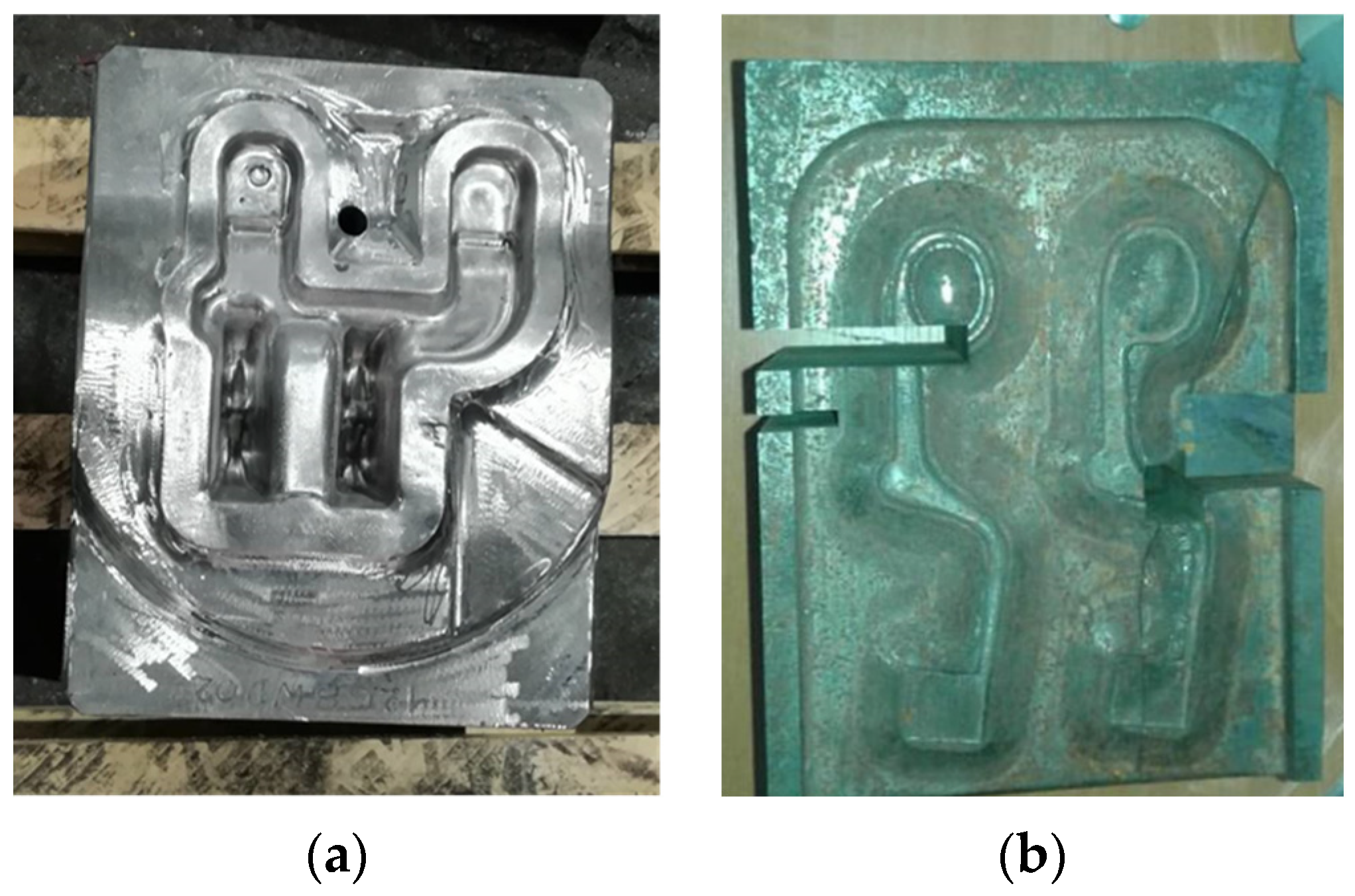



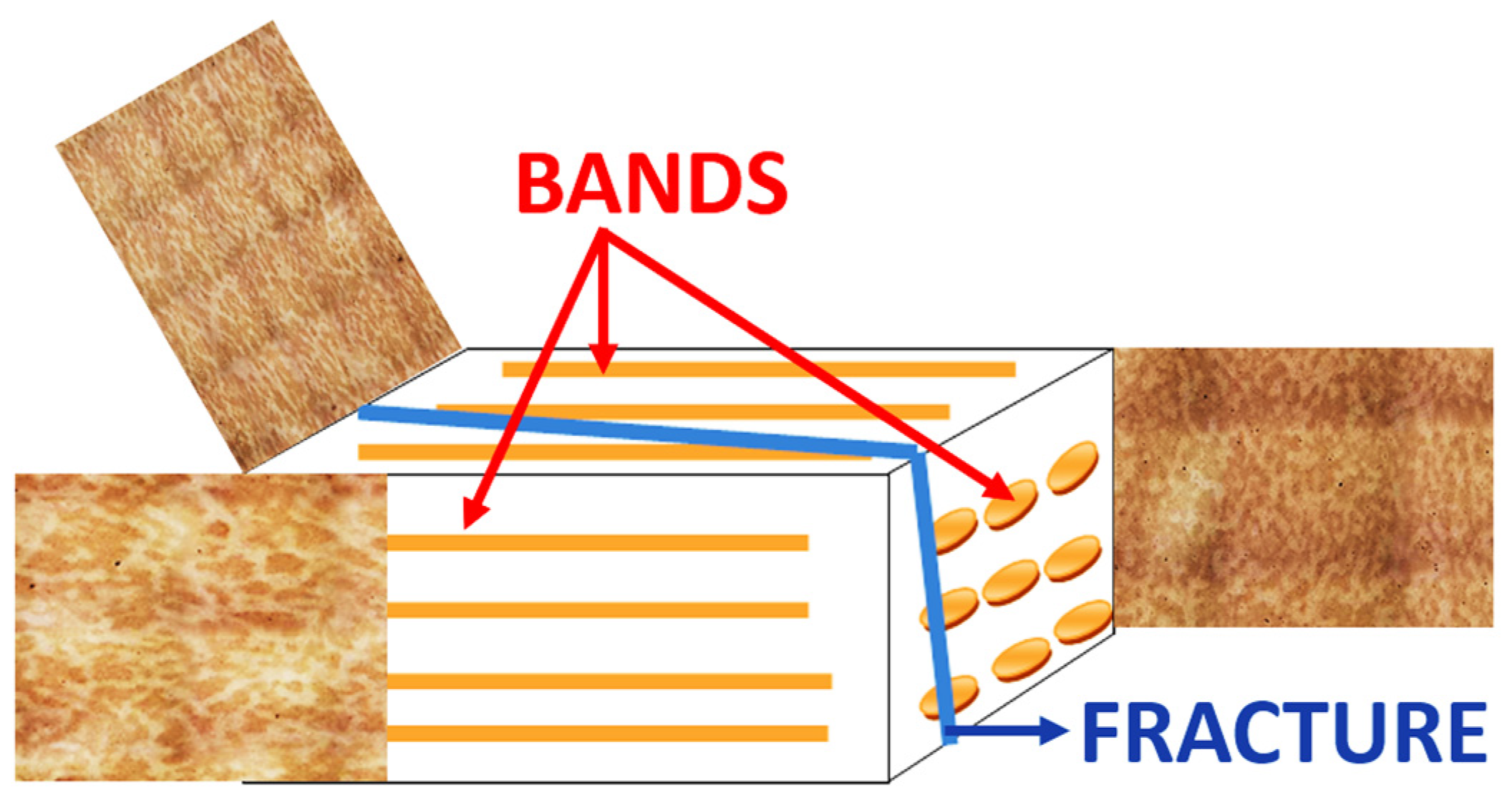
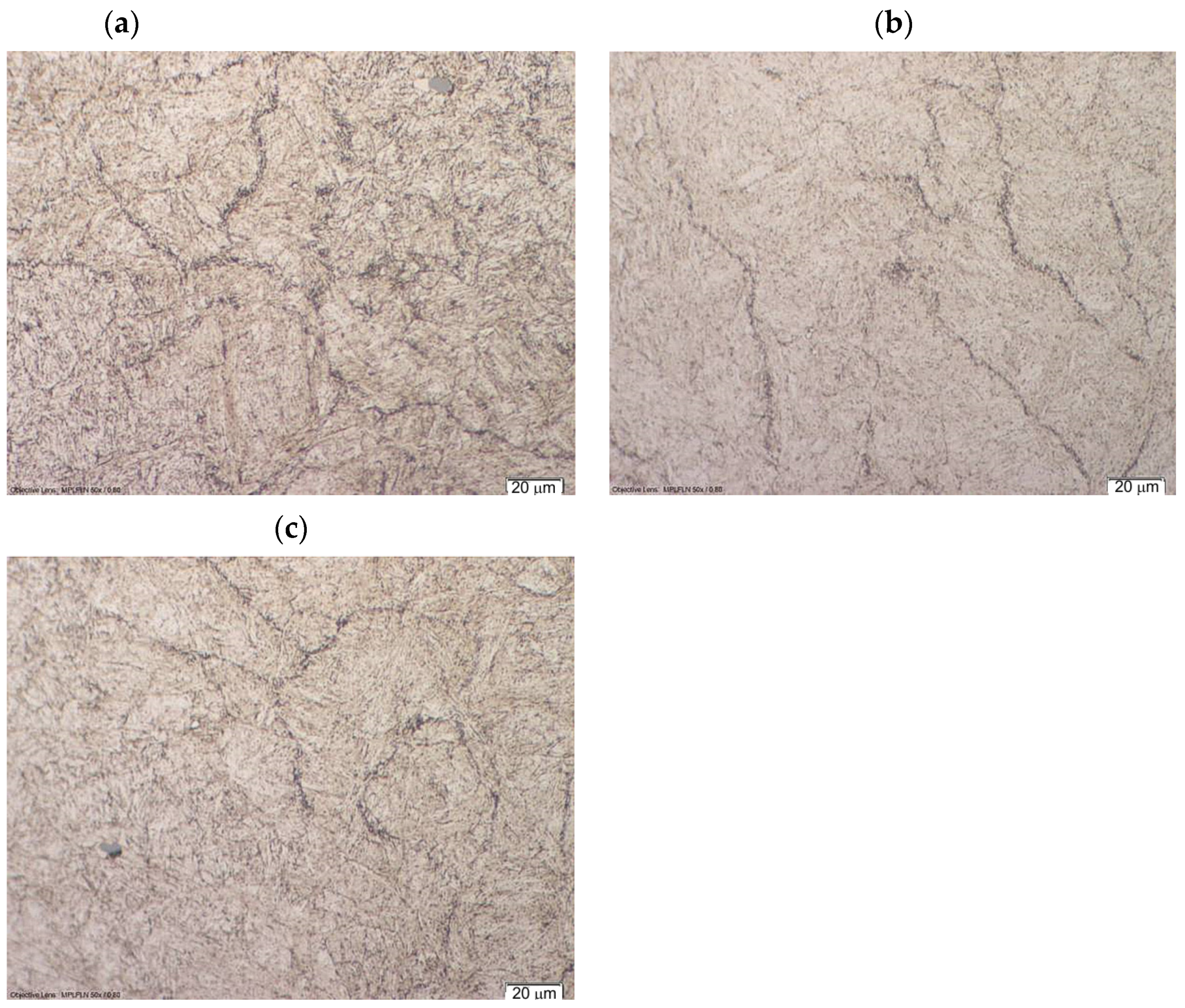

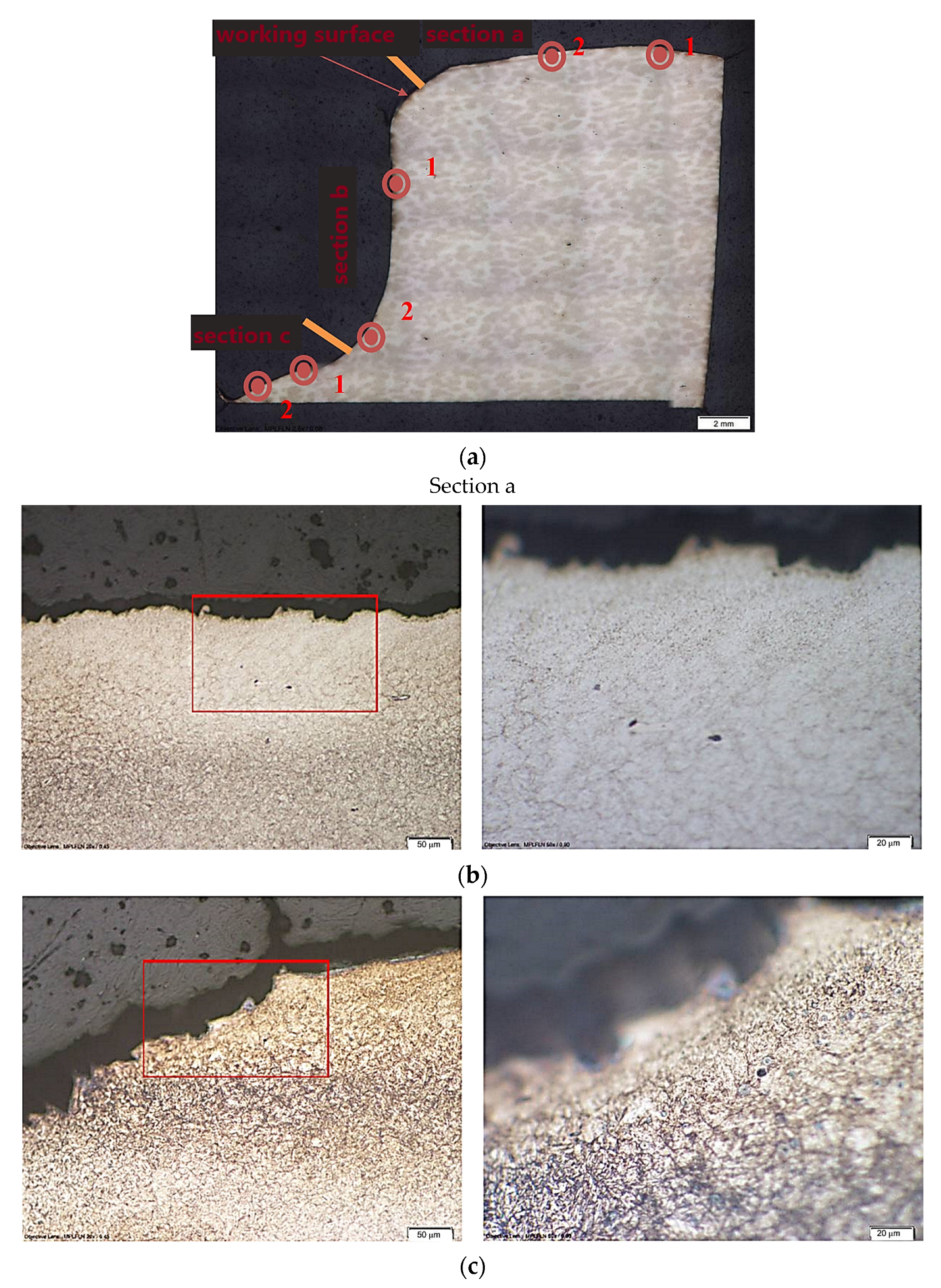


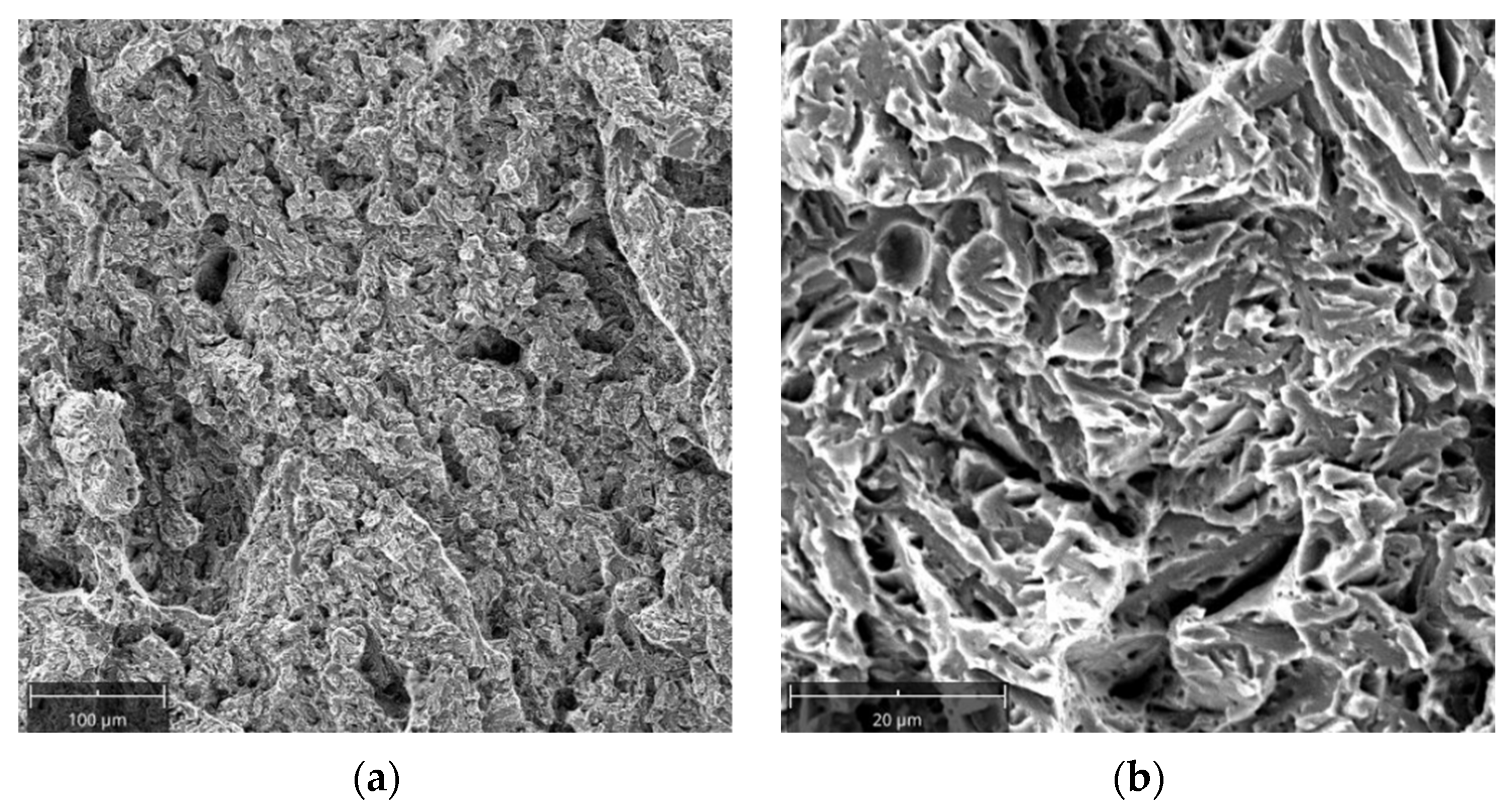





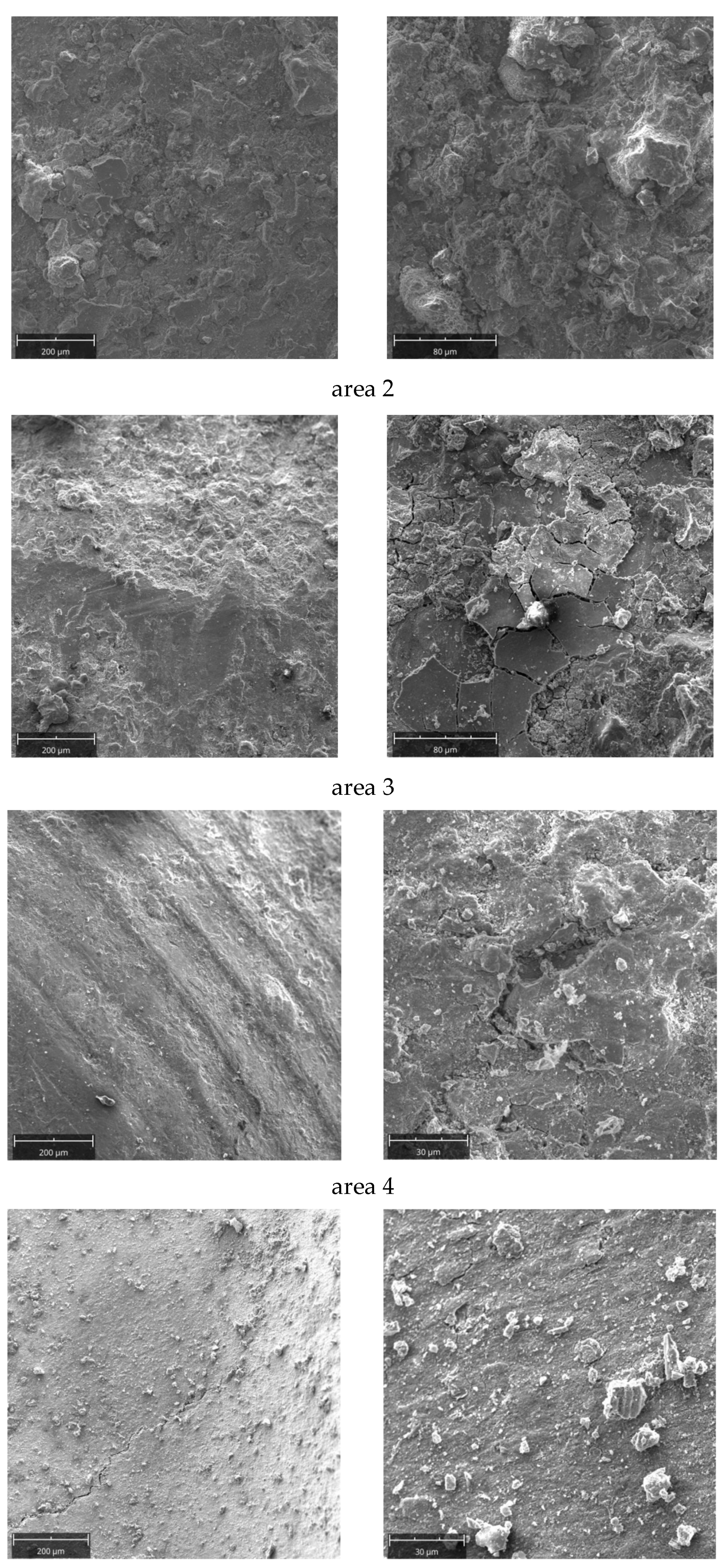
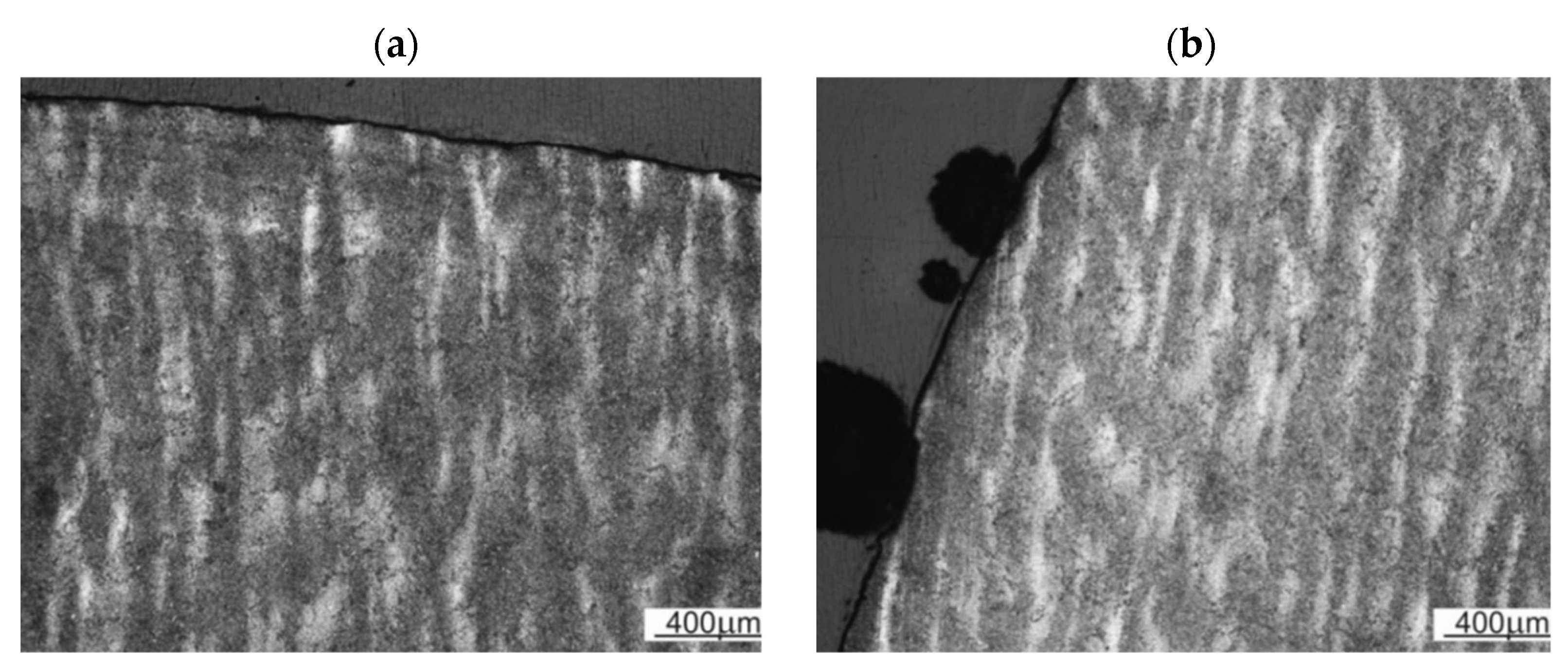
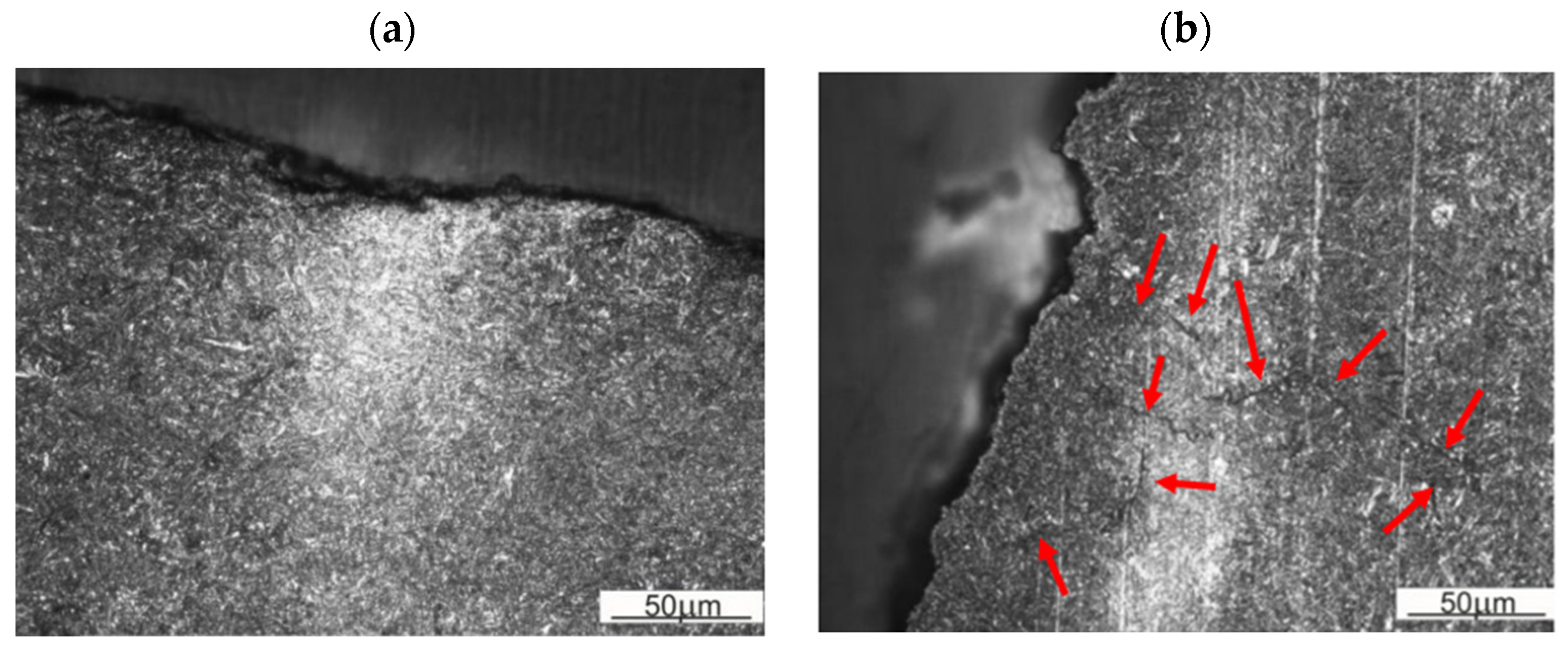
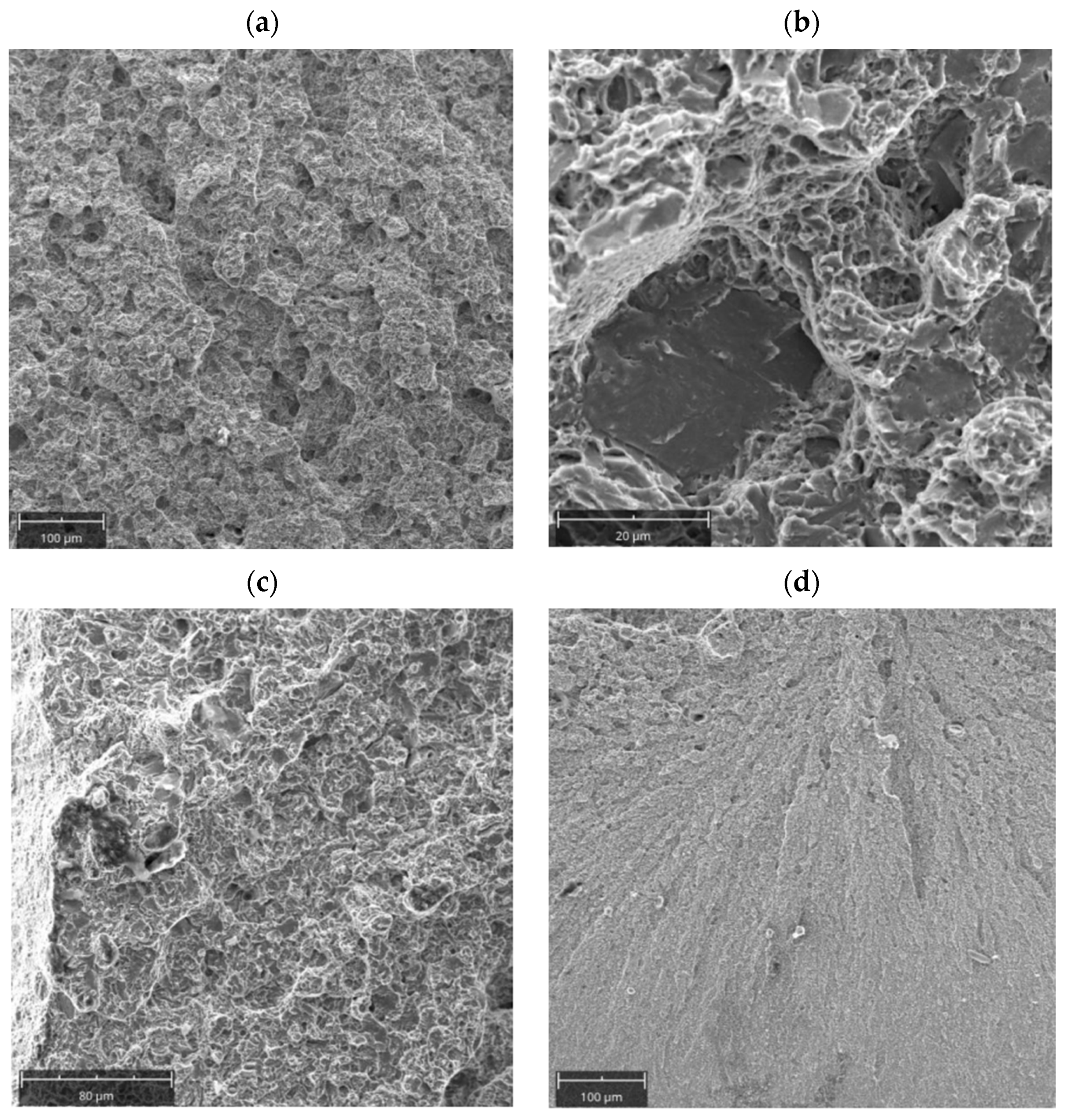
| Chemical Composition, wt. % | ||||||||||
|---|---|---|---|---|---|---|---|---|---|---|
| C | Mn | Si | P | S | Cr | Mo | Ni | V | Fe | |
| X40CrMoV5-1 | 0.39 | 0.30 | 0.94 | 0.013 | 0.010 | 4.87 | 1.22 | 0.18 | 0.89 | Bal. |
| 55NiCrMoV7 | 0.49 | 0.71 | 0.35 | 0.020 | 0.010 | 0.99 | 0.40 | 1.53 | 0.09 | Bal. |
Disclaimer/Publisher’s Note: The statements, opinions and data contained in all publications are solely those of the individual author(s) and contributor(s) and not of MDPI and/or the editor(s). MDPI and/or the editor(s) disclaim responsibility for any injury to people or property resulting from any ideas, methods, instructions or products referred to in the content. |
© 2023 by the authors. Licensee MDPI, Basel, Switzerland. This article is an open access article distributed under the terms and conditions of the Creative Commons Attribution (CC BY) license (https://creativecommons.org/licenses/by/4.0/).
Share and Cite
Krawczyk, J.; Łukaszek-Sołek, A.; Śleboda, T.; Lisiecki, Ł.; Bembenek, M.; Cieślik, J.; Góral, T.; Pawlik, J. Tool Wear Issues in Hot Forging of Steel. Materials 2023, 16, 471. https://doi.org/10.3390/ma16020471
Krawczyk J, Łukaszek-Sołek A, Śleboda T, Lisiecki Ł, Bembenek M, Cieślik J, Góral T, Pawlik J. Tool Wear Issues in Hot Forging of Steel. Materials. 2023; 16(2):471. https://doi.org/10.3390/ma16020471
Chicago/Turabian StyleKrawczyk, Janusz, Aneta Łukaszek-Sołek, Tomasz Śleboda, Łukasz Lisiecki, Michał Bembenek, Jacek Cieślik, Tomasz Góral, and Jan Pawlik. 2023. "Tool Wear Issues in Hot Forging of Steel" Materials 16, no. 2: 471. https://doi.org/10.3390/ma16020471
APA StyleKrawczyk, J., Łukaszek-Sołek, A., Śleboda, T., Lisiecki, Ł., Bembenek, M., Cieślik, J., Góral, T., & Pawlik, J. (2023). Tool Wear Issues in Hot Forging of Steel. Materials, 16(2), 471. https://doi.org/10.3390/ma16020471






